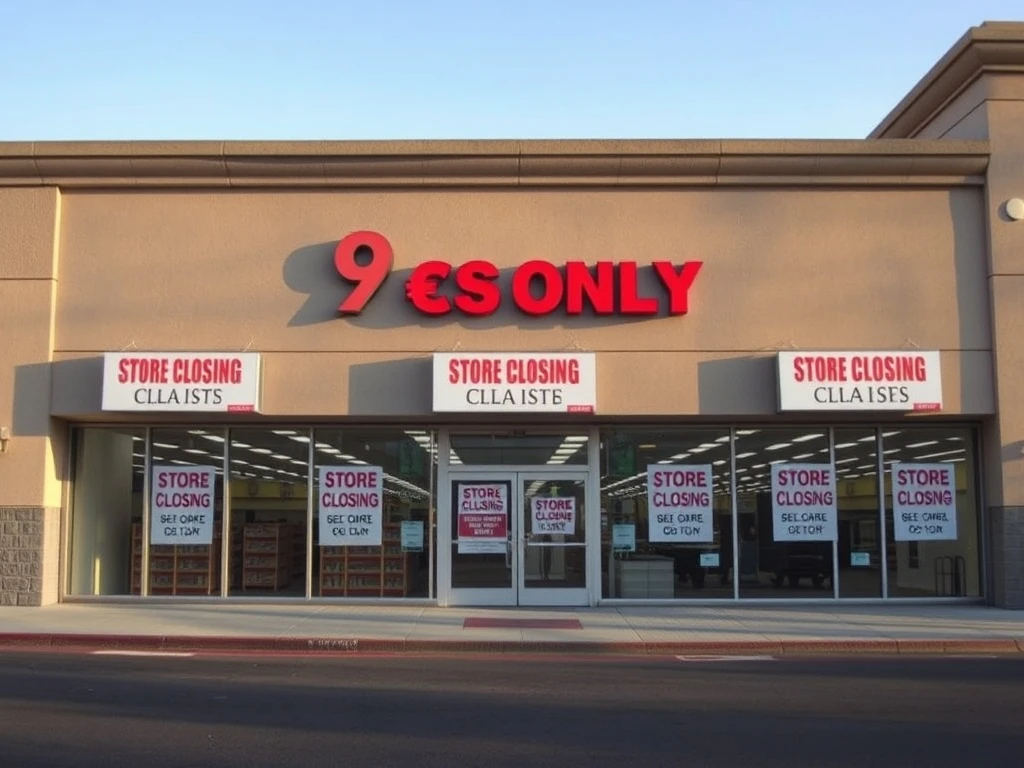The retail landscape constantly shifts. Recently, a significant player announced its complete exit. 99 Cents Only Stores, a long-standing discount retailer, confirmed the closure of all its operations. This move impacts numerous communities. It also signals deeper challenges within the discount retail sector. Shoppers, employees, and suppliers face significant changes. Furthermore, this closure highlights the intense pressures facing traditional brick-and-mortar retailers today. Understanding these dynamics is crucial for anyone interested in business and entrepreneurship.
The End of an Era for 99 Cents Only Stores
Initially, the news emerged in early April. 99 Cents Only Stores declared its intention to cease all business operations. This decision affects 371 stores. These locations span four key states: California, Texas, Arizona, and Nevada. The company has already commenced liquidation sales. This process aims to clear all merchandise quickly. Consequently, shoppers are finding deep discounts on remaining stock. The closure marks the end of an era for a retailer that served communities for over four decades. It provided essential goods at budget-friendly prices. Many consumers relied on these stores for everyday necessities.
For many, 99 Cents Only Stores represented more than just a place to shop. It offered affordability. It also provided a unique shopping experience. Its business model focused on selling a wide variety of items, all priced at 99.99 cents or less. Over time, the pricing strategy adapted. Prices sometimes exceeded the original 99-cent limit. However, the core value proposition remained strong. This allowed the company to compete effectively for many years. Now, this staple of discount retail is disappearing from the market entirely.
Unpacking the Reasons Behind the Closure
Several complex factors contributed to the downfall of 99 Cents Only Stores. No single issue caused the closure. Instead, a confluence of economic headwinds and market shifts created an unsustainable environment. Understanding these challenges provides insight into the broader retail industry struggles. Here are some primary reasons:
- Inflationary Pressures: Rising costs severely impacted the business. Everything from merchandise acquisition to transportation became more expensive. For a retailer built on razor-thin margins, these increases were devastating. It became increasingly difficult to source products at prices that allowed for profitable resale under a discount model.
- Supply Chain Disruptions: The global supply chain faced unprecedented challenges. Delays and increased shipping costs directly affected inventory levels and operational expenses. Consistent product availability is vital for discount retailers. Disruptions made this consistency hard to maintain.
- Shifting Consumer Habits: Consumers increasingly turn to online shopping. E-commerce platforms offer convenience and competitive pricing. This trend eroded foot traffic for many brick-and-mortar stores. Furthermore, evolving consumer preferences favored larger, more diverse retailers or specialized online shops.
- Intense Competition: The discount retail space is highly competitive. Rivals like Dollar Tree, Dollar General, Family Dollar, and even larger players like Walmart and Target offer similar products. These competitors often have greater economies of scale. They can negotiate better prices with suppliers. This put immense pressure on 99 Cents Only Stores.
- Rising Operational Costs: Labor costs, rent, and utility expenses have steadily climbed. Operating hundreds of physical locations became financially burdensome. These fixed costs cut deeply into profit margins, especially when sales stagnated or declined.
Ultimately, these combined pressures proved too great. The company could not adapt quickly enough. It faced a difficult decision. Consequently, the only viable path was to liquidate assets and close all remaining stores.
The Impact on Communities and the Retail Landscape
The closure of 99 Cents Only Stores carries significant implications. Firstly, it results in substantial job losses. Thousands of employees across four states are now seeking new employment. This creates economic hardship for many families. Secondly, communities lose an affordable shopping option. Low-income households often rely on discount stores for essential goods. Their absence creates a void. Local economies may also feel the pinch from reduced commercial activity.
From a broader perspective, this event signals a continued consolidation within the retail sector. Smaller or less adaptable chains struggle to compete. Larger, more diversified retailers often absorb their market share. This trend has been visible for years. It accelerated during recent economic volatility. Furthermore, it prompts questions about the future of traditional discount models. Can a single-price point strategy survive in today’s dynamic market? Many analysts believe sustained innovation is critical for survival.
For example, some dollar store chains have diversified their offerings. They include fresh produce or expanded grocery sections. Others have invested heavily in their online presence. These strategies aim to meet evolving consumer demands. 99 Cents Only Stores, however, struggled to make such transformative shifts. Their legacy business model became a liability rather than an asset in a changing environment. Therefore, their closure serves as a stark reminder of retail’s unforgiving nature.
A Look at the Broader Retail Trends
The situation with 99 Cents Only Stores is not isolated. It reflects wider trends impacting the retail industry. Many businesses face similar challenges. The concept of a “retail apocalypse” gained traction a few years ago. While exaggerated for some sectors, it remains a reality for others. Stores that fail to innovate or adapt to new market conditions are vulnerable. Conversely, retailers that embrace technology and customer-centric strategies often thrive.
Consider the rise of e-commerce. Online sales continue to grow exponentially. This growth diverts consumer spending from physical stores. Furthermore, the convenience of home delivery and vast product selections online appeal to modern shoppers. Brick-and-mortar stores must offer unique experiences. They need to provide value beyond just products. This includes personalized service, engaging in-store events, or seamless omnichannel integration. Without these, they risk obsolescence.
Another significant trend is the increasing polarization of retail. Luxury brands and ultra-discount stores often perform well. Mid-tier retailers, however, face the most pressure. Consumers either seek premium experiences or rock-bottom prices. The middle ground is shrinking. This puts chains like 99 Cents Only Stores, which occupied a unique niche, in a precarious position. Consequently, their business model became less viable over time.
The Future of Discount Retail and Consumer Choices
What does the closure of 99 Cents Only Stores mean for the future of discount retail? It certainly signals a period of adjustment. Other discount chains may see an uptick in business. Shoppers previously loyal to 99 Cents Only Stores will seek alternatives. This could benefit competitors like Dollar Tree, Family Dollar, or independent discount retailers. Moreover, grocery stores and big-box retailers might also capture some of this displaced spending. They offer a wider range of products, including discounted items.
The emphasis on value will not disappear. Consumers remain budget-conscious. They will continue to seek deals. However, the channels through which they find these deals are changing. Online marketplaces are increasingly popular. Digital coupons and loyalty programs also play a larger role. Physical discount stores must find new ways to attract and retain customers. This could involve:
- Enhanced store experiences: Making shopping more enjoyable and convenient.
- Diversified product lines: Offering fresh food or specialized goods.
- Technological integration: Implementing self-checkout, click-and-collect, or mobile apps.
- Strategic partnerships: Collaborating with other businesses to offer bundled services or products.
Ultimately, the retail landscape remains dynamic. While some businesses falter, others emerge stronger. The closure of 99 Cents Only Stores is a significant event. It reflects the ongoing evolution of how consumers shop and how retailers must adapt to survive. This situation serves as a powerful case study for businesses navigating today’s complex economic environment.
Frequently Asked Questions (FAQs)
Q1: Why did 99 Cents Only Stores close all its locations?
A1: 99 Cents Only Stores closed due to a combination of factors. These included persistent inflationary pressures, increased supply chain costs, shifts in consumer spending habits towards online retail, and intense competition from other discount retailers and larger chains. These challenges made their business model unsustainable.
Q2: How many stores were affected by the 99 Cents Only Stores closure?
A2: The closure impacted all 371 99 Cents Only Stores locations. These stores were spread across four states: California, Texas, Arizona, and Nevada.
Q3: What will happen to the employees of 99 Cents Only Stores?
A3: The closure resulted in significant job losses for thousands of employees across the affected states. The company is undergoing liquidation, and employees are being laid off as stores cease operations.
Q4: Will other discount stores also close down?
A4: The retail industry is highly competitive and constantly evolving. While the closure of 99 Cents Only Stores highlights challenges, it does not necessarily mean other discount stores will follow suit. Many competitors are adapting by diversifying offerings, investing in technology, or optimizing their supply chains to remain competitive.
Q5: Where can shoppers find similar deals now that 99 Cents Only Stores are closed?
A5: Shoppers looking for similar deals can explore other discount retailers like Dollar Tree, Dollar General, and Family Dollar. Additionally, large retailers like Walmart and Target often have clearance sections and value-priced items. Online marketplaces also offer competitive pricing on a wide range of products.
























